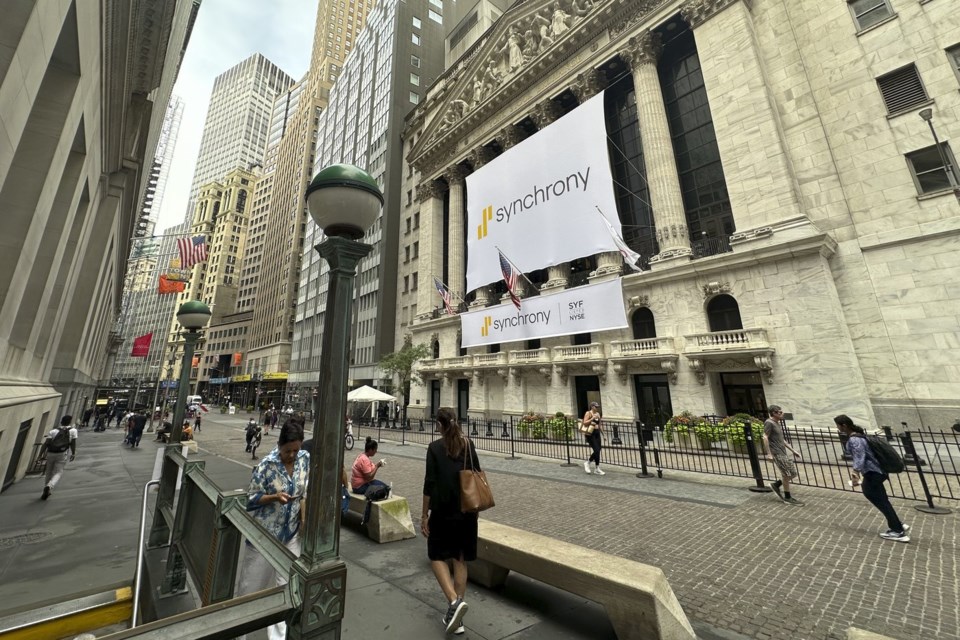NEW YORK (AP) — Just a day after rallying on hopes that the Federal Reserve is , U.S. stocks tumbled Thursday after data raised worries the Fed may have missed its window to do so before undercutting the .
The S&P 500 sank 1.4% after a report showed U.S. , and its contraction is accelerating. Manufacturing has been one of areas of the economy hurt most by high rates, and the report from the Institute for Supply Management helped extinguish what had been gains for U.S. stock indexes early in the morning.
The Dow Jones Industrial Average dropped 494 points, or 1.2%, and had been down more than 700 points earlier in the day, while the Nasdaq composite sank 2.3%.
The action was even stronger in the bond market, where the yield on the 10-year Treasury tumbled below 4%, back to where it was in February. Besides the soft manufacturing data, reports earlier in the morning showed that the number of U.S. workers applying for jobless benefits hit its highest level in about a year and that improved during the spring.
Together, the data likely remove upward pressure on inflation and give more leeway for the Federal Reserve to . A day earlier, yields sank after Fed Chair Jerome Powell gave the clearest indication yet that enough for an easing of rates to begin in September.
But the data also raised worries that the Fed may have held rates too high for too long in its zeal to stifle inflation. The Fed has been keeping its main interest rate at a two-decade high for roughly a year, and that has made it more expensive to borrow to , car or anything on credit cards. And it could take months to a year for the full effects of a rate cut to filter out into the economy.
“Markets are thinking maybe the Federal Reserve should have cut yesterday,” according to Jamie Cox, managing partner for Harris Financial Group.
Stocks of companies whose profits are most closely tied to the economy’s strength had some of Wall Street’s sharper drops. Energy stocks in the S&P 500 fell 2.6%, for example, while industrial companies in the index weakened by 1.8%.
The small stocks in the Russell 2000 index dropped 3%. They had soared more than the rest of the market last month on hopes that the economy would remain solid as interest rates come down, a potent cocktail for them.
The weak economic numbers raise the stakes for an already highly anticipated employment report coming on Friday. Economists expect it to show a slight slowdown in U.S. hiring last month, and Wall Street’s hope is for a Goldilocks type of reading that is neither so hot that it puts upward pressure on inflation nor so cold that it worsens worries about a possible recession.
But the figures could be skewed by the effects of Hurricane Beryl, warns Kevin Khang, senior international economist at Vanguard. It could mean a headline number that looks worse than underlying fundamentals suggest.
The S&P 500 would have dropped even more Thursday if not for . The company behind Facebook and Instagram climbed 4.8% after reporting profit and revenue for the latest quarter that topped analysts’ expectations.
Uncertainty was high heading into its report after other members of the highly influential group of stocks known as the “ ” had underwhelmed investors. This handful of Big Tech stocks drove the S&P 500 to dozens of records this year, in part on the technology. But their momentum turned last month on worries investors had taken their prices too high and expectations for their profit gains had grown too difficult to meet.
Other technology companies got a less welcoming reception from investors. ARM Holdings delivered better profit and revenue for the latest quarter than expected, for example. But its U.S.-listed shares nevertheless tumbled 15.7%. The U.K. chip company did not increase its forecasts for revenue and profit this fiscal year, despite its strong numbers.
Amazon and Apple which like Meta Platforms are also members of the “Magnificent Seven,” were two of the heaviest weights on the S&P 500. Each fell at least 1.6% as investors waited for their latest profit reports, which arrived after trading ended for the day.
All told, the S&P 500 fell 75.62 points to 5,446.68. The Dow dropped 494.82 to 40,347.97, and the Nasdaq tumbled 405.25 to 17,194.15.
In the bond market, the yield on the 10-year Treasury slumped to 3.97% from 4.04% late Wednesday and from 4.70% in April.
Traders are unified in their belief the Federal Reserve will cut its main interest rate in September. The only question is how many times it may cut this year and next.
Across the Atlantic, the Bank of England since the onset of the COVID-19 pandemic in early 2020. The FTSE 100 in London fell 1% after erasing an earlier gain, and stock indexes were also weaker across much of Europe and Asia.
Japan’s Nikkei 225 fell 2.5%. A day earlier, the Bank of Japan raised interest rates, a move that helps push up the value of the yen against the U.S. dollar. Such swings can hurt the profits of exporters, and Toyota’s stock tumbled 8.5% in Tokyo Thursday even though it reported .
___
AP Business Writers Yuri Kageyama and Matt Ott contributed.
Stan Choe, The Associated Press




